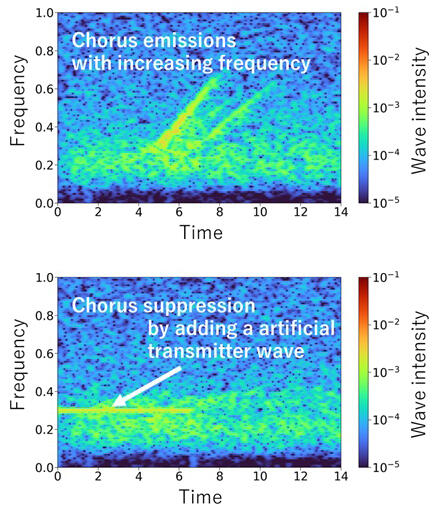A joint research group including Associate Professor Mitsunori Ozaki and Professor Satoshi Yagitani of the School of Electrical, Information and Communication Engineering of the College of Science and Engineering at Kanazawa University and Specially Appointed Professor Yoshiharu Omura of the Research Institute for Sustainable Humanosphere at Kyoto University announced that they successfully analyzed the artificial suppression of the generation of plasma waves (chorus radiation) that accelerate electrons in space until they become radiation. This new technology of artificially controlling the plasma environment using electromagnetic waves from the ground and space is expected to contribute to reducing the deterioration and failure of electronic circuits caused by radiation in the space utilization infrastructure. The results were published in the international journal Geophysical Research Letters on October 17.

In the absence of artificial radio waves (top), chorus radiation occurs with increasing frequency. By contrast, when artificial radio waves are present (bottom), the electron motion that produces nonlinear current, which in turn generates chorus radiation, is disrupted by artificial radio waves, suppressing the occurrence of chorus radiation.
Provided by Kanazawa University
In space around the Earth, there is a region called the radiation belt, where highly energetic electrons are present. In this context, measures to protect electronic circuits installed on satellites from space radiation are considered essential. The source of radiation belt electrons is electromagnetic waves called chorus radiation, which acts as a natural accelerator and accelerates low-energy electrons into radiation belt electrons.
In this study, the research group investigated an artificial control that suppresses the generation of chorus radiation by inhibiting the nonlinear electron motion, which changes the frequency of electromagnetic waves by generating electric currents. The effect of an increase in chorus radiation with and without artificial radio waves was investigated. The generation of chorus radiation was successfully suppressed by applying artificial radio waves with appropriate frequency and amplitude. The research group has revealed that nonlinear electron motion that generates chorus radiation is affected by the applied artificial radio waves.
Because the application of artificial radio waves prevents the generation of chorus radiation, it may reduce the generation rate of radiation belt electrons. By adjusting the frequency and amplitude of artificial radio waves, humans can artificially control chorus radiation that occurs in the radiation belt and radiation belt electrons that are accelerated by it.
Ozaki said, "As we approach the 'maximum' of solar activity, errors in satellite positioning services can be increased by active-space plasma environment, and space weather disasters can cause communication disruptions. To cope with these problems, we hope to contribute not only to understanding and forecasting the current situation, but also to the development of new technologies to 'control' space plasma. To this end, we hope to conduct an experiment using artificial radio waves in the near future to demonstrate the accuracy of this analysis."
Journal Information
Publication: Geophysical Research Letters
Title: Suppression of Nonlinear Chorus Wave Growth by Active Control of Gyroresonant Interactions With Electron Hole Deformation
DOI: 10.1029/2024GL112218
This article has been translated by JST with permission from The Science News Ltd. (https://sci-news.co.jp/). Unauthorized reproduction of the article and photographs is prohibited.




